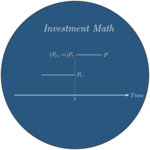Discrete Time Lognormal Dynamics
This post introduces discrete time price dynamics in a log-normal setup. This framework allows an easy translation of some of the continuous time results discussed on this site.
Reminder on log normality The random variable \(X\) has a log-normal distribution if \(x=\log(X)\) has a normal distribution. If the distribution of \(x\) is \(\cal{N}(\mu,\sigma)\), then we will note the distribution of \(X\) \(\cal{L}(\mu,\sigma)\). Its mean is: \[\exp(\mu+\frac{1}{2}\sigma^{2}).\] This is consistent with the convexity of the exponential function and the Jensen effect1. Whereas \(x\) has a distribution which is centered around its mean \(\mu\), the distribution of \(X\) is positively skewed. Its median is \(\exp(\mu)\) which is lower than its mean \(\exp(\mu+\frac{1}{2}\sigma^{2})\) by the factor \(\exp(-\frac{1}{2}\sigma^{2})\). Log normal price dynamics Suppose now that we have a value process \((P_{t})_{t \in \mathbb{N}}\) such that as seen from date \(t\), \(P_{t+1}/P_{t}\) is log-normal \(\cal{L}(\mu_{t+1},\sigma_{t+1})\). More explicitly, we assume that the variables \(\mu_{t+1}\) and \(\sigma_{t+1}\) are \(\cal{F}_{t}\) measurable. Then: \[E_{t}[\frac{P_{t+1}}{P_{t}}]=\exp(\mu_{t+1}+\frac{1}{2}\sigma_{t+1}^{2}).\] I will note \(r_{t+1}=\mu_{t+1}+\frac{1}{2}\sigma_{t+1}^{2}\) the log of the sequential expected return as of date \(t\). With this notation, we can now write: \[\frac{P_{t+1}}{P_{t}}=\exp(r_{t+1}+\sigma_{t+1}\varepsilon_{t+1}-\frac{1}{2}\sigma_{t+1}^{2}),\] where by construction, \(\varepsilon_{t+1}\) is \(\cal{N}(0,1)\). We can also write: \[\frac{P_{t+1}}{P_{t}}=\exp(r_{t+1})\exp(\sigma_{t+1}\varepsilon_{t+1}-\frac{1}{2}\sigma_{t+1}^{2}),\] where: \[E_{t}[\exp(\sigma_{t+1}\varepsilon_{t+1}-\frac{1}{2}\sigma_{t+1}^{2})]=1,\] so that \(\exp(\sigma_{t+1}\varepsilon_{t+1}-\frac{1}{2}\sigma_{t+1}^{2})\) can be interpreted as a multiplicative surprise. It is indeed the martingale ratio of a multiplicative martingale (see the notion of martingale difference in this post.). This multiplicative surprise has mean \(1\) but median \(\exp(-\frac{1}{2}\sigma_{t+1}^{2})<1\). We have thus decomposed the return into its expected component and a surprise. This is really a discrete time version of the usual geometric Brownian diffusion: \[\frac{dP_{t}}{P_{t}}=r_{t}dt+\sigma_{t}dB_{t}.\] Intuition is sometimes easier to develop working on the discrete time model. As a final remark, we need to emphasize that although the shocks in the above discrete time model are conditionally log-normal, it does not imply that prices have log-normal marginal distributions. This is the case if \((\mu_{t})_{t \in \mathbb{N}}\) and \((\sigma_{t})_{t \in \mathbb{N}}\) are deterministic processes, but it fails to be the case in general.
Links
If \(f(\cdot)\) is a conxex function (\(\mathbb{R} \rightarrow \mathbb{R}\)) and \(z\) is a random variable, \(E[f(z)]\geq f(E[z])\).↩︎
